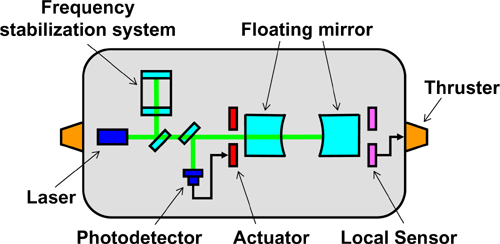|
|
|
|||||
|
|
|
|||||
|
DECIGO stands for DECi-hertz Interferometer Gravitational wave Observatory. It is a gravitational wave antenna in space operating in the 0.1 - 10 Hz frequency band. We propose DECIGO as the Japanese detector to be built after the ground-based detector LCGT.
|
|
The primary objective of DECIGO is to directly observe the beginning of the universe (10-36-10-34 sec after the beginning), and thus possibly reveal its mysterious origin. This is possible only by detecting gravitational waves, because electromagnetic waves cannot give us direct information about the first 380,000 years. Other objectives are to measure the acceleration of the expansion of the universe to further characterize the dark energy, and to observe the formation of giant black holes in the center of galaxies.
|
|
DECIGO consists of three drag-free spacecraft, 1,000 km apart from each other. A drag-free spacecraft is a spacecraft which moves according to only gravity, but not solar radiation pressure, etc.; we can realize this by controlling the relative position of the outer spacecraft with respect to a proof mass inside. DECIGO measures an infinitesimal change in the distance between the spacecraft caused by gravitational wave using a laser interferometer.
|
 |
||
|
DECIGO Pathfinder (DPF) is a spacecraft that will test, in space, the technologies required to realize DECIGO. These technologies include (1) Drag-free spacecraft, (2) Frequency-stabilized laser, and (3) Fabry-Perot cavity control. In addition, DPF can have a role as a scientific mission. DPF could detect gravitational waves coming from the coalescence of intermediate-mass black hole binaries in our galaxy. Also, it could measure the distribution and variation of the gravitational field of the earth. Consequently, DPF is one of the important mission candidates for the small science spacecraft series run by JAXA/ISAS.
|
|
DPF measures the distance between two floating mirrors inside a drag-free spacecraft using a laser interferometer. The two mirrors are controlled to be floating using local sensors and actuators. A tiny change in the distance between the two mirrors caused by gravitational waves will be measured by a Fabry-Perot laser interferometer. The frequency of the laser is stabilized to improve the sensitivity of DPF.
|
 |
||